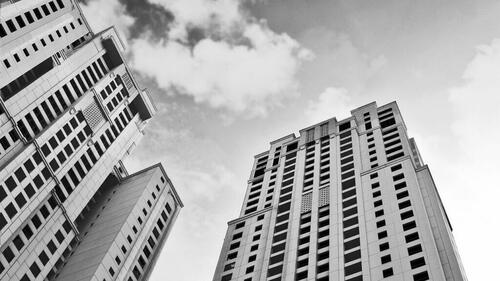The Fed Blew Up Another Real Estate Bubble And It’s Losing Air
Authored by Michael Maharrey via SchiffGold.com,
In March, I warned that the commercial and investment real estate markets could be the next thing to break in this bubble economy. A recent article in the Wall Street Journal put a face on my warning.
The rampant money creation and zero percent interest rates during the COVID pandemic on top of three rounds of quantitative easing and more than a decade of artificially low interest rates in the wake of the 2008 financial crisis created all kinds of distortions and malinvestments in the economy and the financial system. It was inevitable that something would break when the Federal Reserve tried to raise interest rates in order to fight the price inflation it caused with its loose monetary policy.
Easy money is the lifeblood of the US economy and financial system. The Fed started draining that lifeblood away when it stepped in to fight the price inflation it could no longer write off as transitory. There was no way the central bank wasn’t going to break something.
The first crack in the dam was the ongoing financial crisis kicked off by the failures of Silicon Valley Bank and Signature Bank. The Federal Reserve and the US government managed to plug that hole in the dam with a bank bailout. But there are plenty of other cracks in the dam.
For instance, the investment real estate market is under significant pressure due to rising interest rates. As a report by Yahoo Finance noted, “Big owners of property around the country were already under pressure from the Federal Reserve’s aggressive campaign to raise interest rates, which raised borrowing costs and lowered building values.”
It’s not unlike the housing bubble the Fed blew up in 2005 and 2006 but this time it’s concentrated on commercial real estate such as office buildings, multi-family housing complexes, and apartment buildings.
Jay Gajavell puts a human face on this problem.
Gajavell is a Texas real estate investor. According to the Wall Street Journal, his company owned $500 million-plus worth of Sunbelt apartment buildings with more than 7,000 units. He ranked as one of the biggest landlords in Houston.
Gajavelli is what is known as a syndicator. He built his real estate empire using funding from numerous small investors who wanted to get into the real estate game without all the work.
The plan was to buy apartment buildings, upgrade units, raise rents, and sell the buildings for a profit in as little as three years. But as the WSJ described it, these investors were “highly vulnerable to interest-rate increases over the past year that crushed the business model they and thousands of others in similar deals across the US had hoped would make them wealthy.”
The Wall Street Journal described the situation as a “looming investment-property disaster.”
In fact, rising interest rates have already caught up with Gajavelli. In April, his company lost four rental complexes with more than 3,000 units through foreclosure.
The Wall Street Journal explained what did Gajavelli in.
His company had taken out commercial real-estate loans that carried floating interest rates and were adjusted each month. Those types of loans in 2021 offered initial rates as low as 3.5%. Everything changed when the Federal Reserve began raising rates last year, driving up monthly loan payments. Inflation contributed to higher expenses, and Applesway couldn’t raise rents fast enough to keep pace. After bills went unpaid, company properties went into foreclosure.”
It would be one thing if this was an isolated incident, but it isn’t. There are thousands of real estate entrepreneurs like Gajavelli, and many are in a similar situation.
A law passed by Congress in 2012 helped spark the boom in real estate syndication, making it easier to market real estate investments online. According to a Wall Street Journal analysis of Securities and Exchange Commission filings, real estate syndicators reported raising at least $115 billion from investors between 2020 and 2022.
In the wake of the pandemic, there was a major real estate boom spurred by zero percent interest rates and billions of dollars in stimulus money that further incentivized people to invest in real estate.
As housing prices exploded, rents skyrocketed as well. One property manager described it as a mania.
Now the bubble is deflating, as the WSJ describes.
Many syndicators are racing to either raise funds or sell properties before tipping into foreclosure. Most hold balloon-payment loans that require repayment when they come due this year or next. Those syndicators face large payouts at a time when getting new, more affordable property loans will be difficult. Even firms with multibillion-dollar portfolios have used syndication to buy apartment buildings that no longer make enough money to cover debt payments, bond documents show.”
While the Wall Street Journal does a great job of explaining the nuts and bolts of the syndication scheme and mentions the role of rising interest rates in popping the bubble, it completely ignores the Federal Reserve’s role in blowing up the bubble to begin with.
As I pointed out earlier, the Fed created this problem long before when it held rates artificially low for so long. It incentivized all of this borrowing and risk-taking. Everybody just assumed rates would stay low forever so they levered up and took on more and more risk.
Gajavelli probably wouldn’t have been able to build his real estate empire without Fed’s easy money policies.
Unfortunately for Gajavelli and many like him, what the Fed giveth, the Fed taketh away.
This describes the impact of Fed monetary policy on one sector. Bubbles and malinvestments are certainly present in many other sectors of the economy as well. The question is where will the next hole open up in the dam?
Tyler Durden
Thu, 06/01/2023 – 12:30
via ZeroHedge News https://ift.tt/moMUj9B Tyler Durden
